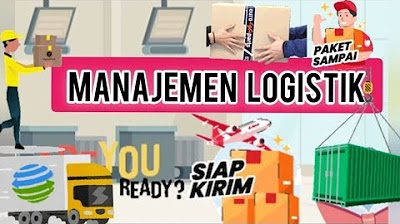The Evolution of Logistics Management: From Ancient Times to the Present Day
Summary
TLDRThis video explores the evolution of logistics management, tracing its development from the early focus on transportation to today's holistic approach through supply chain management. It covers key milestones like the Industrial Revolution, World War II, and the rise of e-commerce. The video also highlights future trends, including the growth of e-commerce, omnichannel retailing, and the impact of emerging technologies like AI and blockchain. Additionally, it addresses challenges like sustainability, data analytics, and the need for flexibility in an increasingly volatile global economy.
Takeaways
- 😀 Logistics management involves planning, organizing, and controlling the flow of goods and services from origin to consumption.
- 😀 Logistics has evolved from a simple focus on transportation to a comprehensive management of the entire supply chain.
- 😀 The four stages of logistics evolution are: the early days, the transportation era, the physical distribution era, and the supply chain management era.
- 😀 In the early days, logistics focused on minimizing transportation costs, and was seen as a cost center rather than a strategic asset.
- 😀 The transportation era (early 20th century) saw advancements like motorized transportation, containerization, and air freight, reducing costs and increasing speed.
- 😀 The physical distribution era (1960s) focused on improving the entire product delivery process, including transportation, warehousing, and order processing.
- 😀 The supply chain management era (1980s) introduced a holistic view, integrating the entire supply chain, from raw materials to customers, leveraging technologies like ERP and SCM software.
- 😀 Key milestones in logistics history include the Industrial Revolution, World War II, the 1970s rise of Just-In-Time (JIT) systems, the 1990s e-commerce boom, and the 2000s rise of globalization.
- 😀 Future trends in logistics include the continued growth of e-commerce, the rise of omnichannel retailing, and the development of technologies like blockchain and AI.
- 😀 Businesses need to focus on sustainability, data analytics, and flexibility to adapt to the evolving demands of global trade and logistics challenges.
Q & A
What is logistics management?
-Logistics management is the process of planning, organizing, and controlling the flow of goods and services from the point of origin to the point of consumption. It includes activities such as transportation, warehousing, inventory management, and order fulfillment.
How has logistics management evolved over time?
-Logistics management has evolved from focusing solely on transportation to a more holistic approach that includes inventory management, warehousing, and order fulfillment. This evolution occurred in four stages: the early days of logistics, the transportation era, the physical distribution era, and the supply chain management era.
What was the focus of logistics in the early days?
-In the early days of logistics, the primary focus was on the physical movement of goods, with businesses concerned primarily about getting their products from where they were made to where they were sold. The main goal was to minimize transportation costs.
What were the key developments during the transportation era?
-The transportation era, beginning in the early 20th century, saw significant advancements such as the widespread use of motorized transportation, containerization, and air freight. These innovations helped reduce transportation costs and increase speed, making logistics more efficient.
What characterized the physical distribution era?
-The physical distribution era, which began in the 1960s, focused on the entire process of getting products to customers. It included transportation, warehousing, inventory management, and order processing. New technologies such as barcodes and electronic data interchange (EDI) were introduced to track goods and improve order accuracy.
What marked the beginning of the supply chain management era?
-The supply chain management era began in the 1980s, with a focus on integrating the entire supply chain, from raw material suppliers to end customers. The development of enterprise resource planning (ERP) systems and supply chain management software allowed for better coordination and visibility across the entire chain.
What are some key milestones in logistics management?
-Key milestones include the Industrial Revolution, which increased the demand for goods and spurred transportation and warehousing innovations; World War II, which saw the development of containerization for international logistics; the rise of just-in-time inventory management in the 1970s; the growth of e-commerce in the 1990s; and globalization in the 2000s, which added complexity to logistics.
How has the rise of e-commerce influenced logistics management?
-E-commerce has dramatically increased the demand for logistics services. This has led to the development of new technologies, such as e-commerce platforms, to improve the efficiency of logistics and meet the demands of fast, reliable delivery to customers.
What are some future trends in logistics management?
-Future trends include the continued growth of e-commerce, the rise of omnichannel retailing, and the development of new technologies like blockchain and artificial intelligence. These trends are expected to increase the complexity of logistics operations and require businesses to adopt new strategies for managing goods and services efficiently.
What role do sustainability and data analytics play in the future of logistics?
-Sustainability is becoming increasingly important as businesses are under pressure to reduce the environmental impact of their logistics operations. Data analytics is also crucial, as it helps businesses gain insights into their supply chains, optimize operations, and make more informed decisions about logistics management.
Outlines

このセクションは有料ユーザー限定です。 アクセスするには、アップグレードをお願いします。
今すぐアップグレードMindmap

このセクションは有料ユーザー限定です。 アクセスするには、アップグレードをお願いします。
今すぐアップグレードKeywords

このセクションは有料ユーザー限定です。 アクセスするには、アップグレードをお願いします。
今すぐアップグレードHighlights

このセクションは有料ユーザー限定です。 アクセスするには、アップグレードをお願いします。
今すぐアップグレードTranscripts

このセクションは有料ユーザー限定です。 アクセスするには、アップグレードをお願いします。
今すぐアップグレード5.0 / 5 (0 votes)






